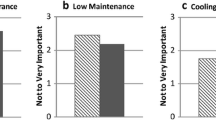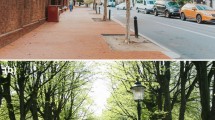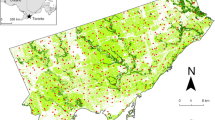Abstract
Despite the fact that forests in urban areas play multiple and often conflicting roles, research and management efforts are typically geared towards a single role or purpose. Urban ecology addresses this multiplicity of function by viewing human and natural systems in urban areas not as separate entities, but as interacting components of an integrated whole. We present an interdisciplinary approach for evaluating the different ways that forests are often valued: economically, socially, and ecologically in residential areas of King County, WA. Economic function is measured as the change in housing prices attributed to location on the gradient, using a hedonic price model. For social function we use a survey to measure (1) residents’ use of parks and forests, and (2) satisfaction with their neighborhoods. We measure ecological function as songbird species richness, using bird survey data. Overlaying the curves of economic, social, and ecological function on the common axis of our urban gradient allows for relationships and tradeoffs to be qualitatively evaluated. Each function responds differently to the gradient. The housing price response is strongest at high and low levels of urbanization, with positive premiums in both areas. Satisfaction with neighborhood attributes decreases with increasing urbanization, while the likelihood of mentioning ‘parks’ as an important element of a resident’s neighborhood increases. Songbird richness peaks in less-developed areas. Evaluating the different functions together is an important step in recognizing and understanding the multiple roles forested areas play.









Similar content being viewed by others
References
Acharya G, Bennett LL (2001) Valuing open space and land-use patterns in urban watersheds. J Real Estate Finance Econ 22(2–3):221–237
Alberti M, Coe A, Botsford E (2001) Quantifying the urban gradient: linking urban planning and ecology. In: Marzluff JM, Bowman R, Donnelly R (eds) Avian ecology in an urbanizing world. Kluwer, Norwell
Alberti M, Marzluff JM, Shulenberger E, Bradley G, Ryan C, Zumbrunnen C (2003) Integrating humans into ecology: opportunities and challenges for studying urban ecosystems. Bioscience 53(12):1169–1179
Blair RB (1996) Land use and avian species diversity along an urban gradient. Ecol Appl 6:506–519
Blumenfeld H (1967) Scale in civic design. In: Spreiregen PD (ed) The modern metropolis: its origins, growth, characteristics, and planning. MIT Press, Cambridge
Bolitzer B, Netusil NR (2000) The impact of open spaces on property values in Portland, Oregon. J Environ Manag 59(3):185–193
Coles R, Bussey S (2000) Urban forest landscapes in the UK: progressing the social agenda. Landsc Urban Plan 52(2–3):181–188
Coley RL, Kuo FE, Sullivan WC (1997) Where does community grow? The social context created by nature in urban public housing. Environ Behav 294:468–492
Cropper ML, Deck LB, McConnell KE (1988) On the choice of functional form for hedonic price functions. Rev Econ Stat 70(4):668–675
Cunningham CR (2006) House price uncertainty, timing of development, and vacant land prices: evidence for real options in Seattle. J Urban Econ 59(1):1–31
Dawe GFM (1995) Species-density in relation to urban open space. Land Contam Reclam 3(2):114–116
Donnelly R, Marzluff JM (2004) Importance of reserve size and landscape context to urban bird conservation. Conserv Biol 18:733–745
Donnelly R, Marzluff JM (2006) Relative importance of habitat quantity, structure, and spatial pattern to birds in urbanizing environments. Urban Ecosyst 9:99–117
Ekeland I, Heckman J, Nesheim L (2004) Identification and estimation of hedonic models. J Polit Econ 112(1):S60–S109
Franklin JF, Dyrness CT (1988) Natural vegetation of Oregon and Washington. Oregon State University Press, Corvallis
Franklin JP, Waddell P (2003) A hedonic regression of home prices in King County, Washington, using activity-specific accessibility measures. In: Proceedings of the Transportation Research Board 82nd Annual Meeting, Washington, DC
Frumkin H, Frank L, Jackson R (2004) The public health impacts of sprawl. Island Press, Washington DC
Geoghegan J, Lynch L, Bucholtz S (2003) Capitalization of open spaces into housing values and the residential property tax revenue impacts of agricultural easement programs. Agric Resour Econ Rev 32(1):33–45
Gobster PH, Westphal LM (2004) The human dimensions of urban greenways: planning for recreation and related experiences. Landsc Urban Plan 68(2–3):147–165
Grimm NB, Grove JM, Pickett STA, Redman CL (2000) Integrated approaches to long-term studies of urban ecological systems. Bioscience 50(7):571–584
Hansen AJ, Knight RL, Marzluff JM, Powell S, Brown K, Gude PH, Jones K (2005) Effects of exurban development on biodiversity: patterns, mechanisms, and research needs. Ecol Appl 15(6):1893–1905
Harnik P, Simms J (2004) Parks: how far is too far? Planning 70:8–11
Kaplan R, Kaplan S (1989) The experience of nature: a psychological perspective. Cambridge University Press, New York
Kearney A, Kaplan S (1997) Towards a methodology for the measurement of knowledge structures of ordinary people. Environ Behav 29(5):579–617
Kearney AR, Bradley G (1998) Human dimensions of forest management: an empirical study of stakeholder perspectives. Urban Ecosyst 2:5–16
Kerpez TA, Smith NS (1990) Competition between European Starlings and native woodpeckers for nest cavities in saguaros. Auk 107:367–375
King County (2000) King County Office of Regional Policy and Planning, the Annual Growth Report 2000. King County, Washington
King County (2001) King County Office of Regional Policy and Planning, King County Comprehensive Plan 2000. King County, Washington
Klingle MW (2001) Urban by nature: an environmental history of Seattle, 1880–1970. Ph.D. dissertation, University of Washington
Korpela KM, Hartig T, Kaiser FG, Fuhrer U (2001) Restorative experience and self-regulation in favorite places. Environ Behav 33:572–589
Kowarik I (1995) On the role of alien species in urban flora and vegetation. In: Pysek P, Prach K, Rejmánek M, Wade PM (eds) Plant invasions: general aspects and special problems. SPB Academic, Amsterdam
Kuo FE, Sullivan WC (2001) Aggression and violence in the inner city: effects of environment via mental fatigue. Environ Behav 33(4):543–571
Kuo FE, Sullivan WC, Coley RL, Brunson L (1998) Fertile ground for community: inner-city neighborhood common spaces. Am J Community Psychol 26(6):823–851
Kweon BS, Sullivan WC, Wiley AR (1998) Green common spaces and the social integration of inner-city older adults. Environ Behav 30(6):832–858
Lancaster K (1966) A new approach to consumer theory. J Polit Econ 74(2):132–157
Marzluff JM (2005) Island biogeography for an urbanizing world: how extinction and colonization may determine biological diversity in human-dominated landscapes. Urban Ecosyst 8:157–177
Marzluff JM, Restani M (1999) The effects of forest fragmentation on avian nest predation. In: Rochelle JA, Lehmann LA, Wisniewski J (eds) Forest wildlife and fragmentation: management and implications. Brill, Leiden, The Netherlands, pp 155–169
Marzluff JM, Ewing K (2001) Restoration of fragmented landscapes for the conservation of birds: a general framework and specific recommendations for urbanizing landscapes. Restor Ecol 9:280–292
Marzluff JM, Bowman R, Donnelly R (2001) A historical perspective on urban bird research: trends, terms, and approaches. In: Marzluff JM, Bowman R, Donnelly R (eds) Avian ecology in an urbanizing world. Kluwer, Norwell
Marzluff JM, Withey JC, Whittaker KA, Oleyar MD, DeLap J, Unfried TM, Rullman S (2007) Consequences of habitat utilization by nest predators and breeding songbirds across multiple scales in an urbanizing landscape. Condor 109:516–534
Mathur S, Waddell P, Blanco H (2004) The effect of impact fees on the price of new single-family housing. Urban Stud 41(7):1303–1312
McDonald LS (2000) Bellevue, its first 100 years. Bellevue Historical Society, Bellevue
McDonnell MJ, Pickett STA (1990) Ecosystem structure and function along urban–rural gradients: an unexploited opportunity for ecology. Ecology 71:1232–1236
McDonnell MJ, Pickett STA, Pouyat RV, Zipperer WC, Parmelee RW, Carreiro MM, Medley K (1997) Ecosystem processes along an urban-to-rural gradient. Urban Ecosyst 1:21–36
McKinney ML (2002) Urbanization, biodiversity, and conservation. BioScience 52(10):883–890
Niemi GJ, McDonald ME (2004) Application of ecological indicators. Ann Rev Ecolog Evolut Syst 35:89–111
Ozretich J (2002) Planned communities build nearly 12,000 new homes. Puget Sound Business Journal, Seattle (September 20, 2002)
Phelps ML (1978) Public works in Seattle: a narrative history, the engineering department 1875–1975. Seattle Engineering Dept., Seattle
Pickett STA, Cadenasso ML, Grove JM, Nilon CH, Pouyat RV, Zipperer WC, Costanza R (2001) Urban ecological systems: linking terrestrial ecological, physical, and socioeconomic components of metropolitan areas. Ann Rev Ecolog Syst 32(1):127–157
PSRC (Puget Sound Regional Council) (2006) Trends in household size. Puget Sound Trends: May 2006
Robinson L, Newell JP, Marzluff JM (2005) Twenty-five years of sprawl in the Seattle region: growth management responses and implications for conservation. Landsc Urban Plan 71:51–72
Rosen S (1974) Hedonic prices and implicit markets: product differentiation in pure competition. J Polit Econ 82(1):34–55
Rothenberg J, Galster GC, Butler RV, Pitkin JR (1991) The maze of urban housing markets: theory, evidence, and policy. University of Chicago Press, Chicago
Sukkop H, Werner P (1982) Nature in cities: a report and review of studies and experiments concerning ecology, wildlife and nature conservation in urban and suburban areas. Council of Europe Nature and Environment Series 28. Council of Europe, Strasbourg
TPL (The Trust for Public Land) (2005) Greenprint for King County. The Trust for Public Land, King County
Turner MG, Gardner RH, O’Neill RV (2001) Landscape ecology in theory and practice. Springer, Heidelberg
Tyrväinen L (1997) The amenity value of the urban forest: an application of the hedonic pricing method. Landsc Urban Plan 37(3–4):211–222
US Census Bureau (2002) County and city data book 2000. US Census Bureau, Washington, DC
Vance JE (1990) The continuing city. Johns Hopkins University Press, Baltimore
Whitney GG (1985) A quantitative analysis of the flora and plant communities of a representative Midwestern US town. Urban Ecol 9:143–160
Acknowledgements
We thank our colleagues in University of Washington’s Urban Ecology Program for useful comments and constructive criticism throughout the duration of this study. Roarke Donnelly and others shared bird survey data. We thank Gordon Bradley, Anne Kearney, Claire Ryan, Kathy Wolf, and Mark van de Kamp for valuable assistance with social survey design and analysis. We also thank Jeff Hepinstall for support with GIS analyses. M. Alberti, G. Bradley, J. Marzluff, and E. Shulenberger provided valuable comments that helped to improve the manuscript. NSF IGERT-0114351 provided support for this study and student fellowships.
Author information
Authors and Affiliations
Corresponding author
Rights and permissions
About this article
Cite this article
Oleyar, M.D., Greve, A.I., Withey, J.C. et al. An integrated approach to evaluating urban forest functionality. Urban Ecosyst 11, 289–308 (2008). https://doi.org/10.1007/s11252-008-0068-5
Published:
Issue Date:
DOI: https://doi.org/10.1007/s11252-008-0068-5




